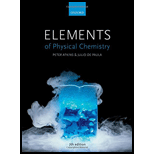
(a)
Interpretation:
The molar Gibbs energy of mixing when the nitrogen and oxygen are mixed to form air at
Concept introduction:
The Gibbs free energy or the free energy change is a
Molal Gibbs free energy can be determined using the following formulas as show below,
The equation for finding
(a)
Explanation of Solution
Given data:
The equation for finding
(b)
Interpretation:
The molar entropy of mixing when the nitrogen and oxygen are mixed to form air at
Concept introduction:
The equation for finding
(b)
Explanation of Solution
Given data:
The equation for finding
(c)
Interpretation:
The mixing is whether spontaneous or not has to be given.
Concept introduction:
The Gibbs free energy or the free energy change is a thermodynamic quantity represented by
Molal Gibbs free energy can be determined using the following formulas as show below,
For an isomermal reaction enthalpy change is zero, thus this equation can be written as,
(c)
Explanation of Solution
The molar Gibbs energy of mixing when the nitrogen and oxygen are mixed to form air at
The above conditions satisfies the criteria for spontaneous.
Therefore, the mixing is spontaneous.
Want to see more full solutions like this?
Chapter 4 Solutions
Elements Of Physical Chemistry
 ChemistryChemistryISBN:9781305957404Author:Steven S. Zumdahl, Susan A. Zumdahl, Donald J. DeCostePublisher:Cengage Learning
ChemistryChemistryISBN:9781305957404Author:Steven S. Zumdahl, Susan A. Zumdahl, Donald J. DeCostePublisher:Cengage Learning ChemistryChemistryISBN:9781259911156Author:Raymond Chang Dr., Jason Overby ProfessorPublisher:McGraw-Hill Education
ChemistryChemistryISBN:9781259911156Author:Raymond Chang Dr., Jason Overby ProfessorPublisher:McGraw-Hill Education Principles of Instrumental AnalysisChemistryISBN:9781305577213Author:Douglas A. Skoog, F. James Holler, Stanley R. CrouchPublisher:Cengage Learning
Principles of Instrumental AnalysisChemistryISBN:9781305577213Author:Douglas A. Skoog, F. James Holler, Stanley R. CrouchPublisher:Cengage Learning Organic ChemistryChemistryISBN:9780078021558Author:Janice Gorzynski Smith Dr.Publisher:McGraw-Hill Education
Organic ChemistryChemistryISBN:9780078021558Author:Janice Gorzynski Smith Dr.Publisher:McGraw-Hill Education Chemistry: Principles and ReactionsChemistryISBN:9781305079373Author:William L. Masterton, Cecile N. HurleyPublisher:Cengage Learning
Chemistry: Principles and ReactionsChemistryISBN:9781305079373Author:William L. Masterton, Cecile N. HurleyPublisher:Cengage Learning Elementary Principles of Chemical Processes, Bind...ChemistryISBN:9781118431221Author:Richard M. Felder, Ronald W. Rousseau, Lisa G. BullardPublisher:WILEY
Elementary Principles of Chemical Processes, Bind...ChemistryISBN:9781118431221Author:Richard M. Felder, Ronald W. Rousseau, Lisa G. BullardPublisher:WILEY





